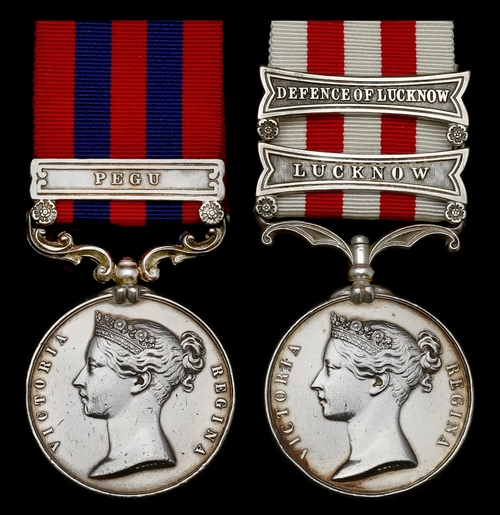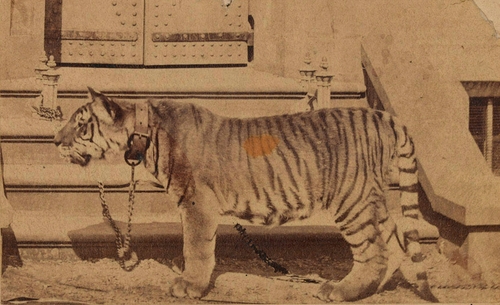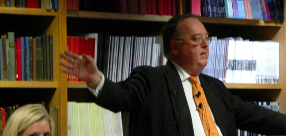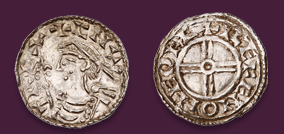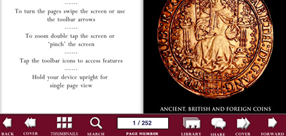Auction: 25003 - Orders, Decorations and Medals
Lot: 49
Pair: Private W. Morrison, 1st Madras European Fusiliers, later 102nd Regiment of Foot (later 1st Battalion, Royal Dublin Fusiliers), who shared in the numerous famed actions of the unit better known as Neill’s “Blue Caps” during the Indian Mutiny
India General Service 1854-95, 1 clasp, Pegu (William Morrison, 1st Madras Fusrs.); Indian Mutiny 1857-59, 2 clasps, Defence of Lucknow, Lucknow (W. Morrison, 1st Madras Fusrs.), very fine (2)
Provenance:
Thomas Lees Collection, Sotheby's, March 1986.
William Morrison was a native of Glasgow, being born circa 1827 and was a plumber by trade upon his joining the East India Company's Army in March 1846. Landing in India via the Asiatic, he joined the 1st Madras European Fusiliers, with whom he was to spend his career.
The unit shared in the actions of the War in Burma, Morrison being '...employed during the progress from 5 April 1852-20 June 1853', time also left on duty in the Depot at Rangoon (Medal & clasp).
He next shared in the many engagements fought by his Regiment in the Indian Mutiny, a full record of which is to be found in Neill’s Blue Caps, by Colonel H. C. Wylly, C.B., variously also being known as the Sweet Lambs. They were to march with Havelock all the distance from Alllahabad to the First Relief of Lucknow, shared in the Defence of the Residency and accompanied the withdrawal to Cawnpore. They made a gallant raid to spike the enemy’s guns at “Cawnpore Battery”, Lucknow, when the “Blue Caps” were ‘...exposed to a very destructive fire from the tops of houses and loopholes’ on their return journey, and compelled to leave behind some of their wounded, and, indeed, shared in the subsequent part in another attack against the enemy in “Phillips’ Garden”.
They went on to play an important role in the final siege and capture of Lucknow and the efforts to pacify Oudh itself. Morrison would have been present for the passage of the Goomtee at Sultanpore, and other minor affairs, besides the defeat of the enemy at Shahpore, A brief account of the Shahpore operation, written by a fellow Madras Fusilier, Lieutenant J. A. Woods, appears in Neill’s Blue Caps:
‘On 7 October I went on an interesting and important raid under Brevet-Major Raikes with the Right Wing and No. 6 Company of ours, 2 R.H.A. guns, a Troop of 7th Hussars, some of Hodson’s Horse under Palliser, 300 of the 5th Punjab Infantry and 25 Sappers & Miners. It was a military picnic in lovely weather and in beautiful country. Marching about a dozen miles a day, in a week we came suddenly one forenoon upon the object of our search. Our cavalry scouts reported a force was then half-a-mile in front, and we came upon the enemy eating their breakfast in fancied security, a few hundred of them on our side of the river, the bulk not yet having crossed. The whole of our little cavalry force charged down upon them at once, closely followed by the 2 guns and the greater part of the infantry. Fifty yards on our side of the river was a ditch concealed by long grass; this was crossed by the Horse, including the artillery, at full gallop; a few Hussars and one of the guns came to grief here, they were all mixed up together but emerged undamaged. The rest profited by their warning and stopped at the brink of the ditch, the guns pounding the flying rebels at short range. A score more of them drowned while crossing by the narrow ford ... ’ A few days later, having blown up a nearby fort, where many concealed arms were found, they returned to Sultanpore.
Morrison remained with the unit until 1861, when the old East India Company Army was abolished. Thus he became a member of the 102nd Regiment of Foot (Royal Madras Fusiliers), which would in time form the 1st Battalion, Royal Dublin Fusiliers. Morrison may well have known their famed mascot Plassey. Named after the Battle of Plassey, the Bengal tiger cub was among a pair captured by Captain Frank Thackwell of the 5th Royal Irish Lancers and later gifted to the 102nd. He eventually was gifted to the London Zoo after having alarmed the residents of the Dover Garrison and died there in 1877; sold together with copied research.
Subject to 20% VAT on Buyer’s Premium. For more information please view Terms and Conditions for Buyers.
Estimate
£800 to £1,200
Starting price
£700

